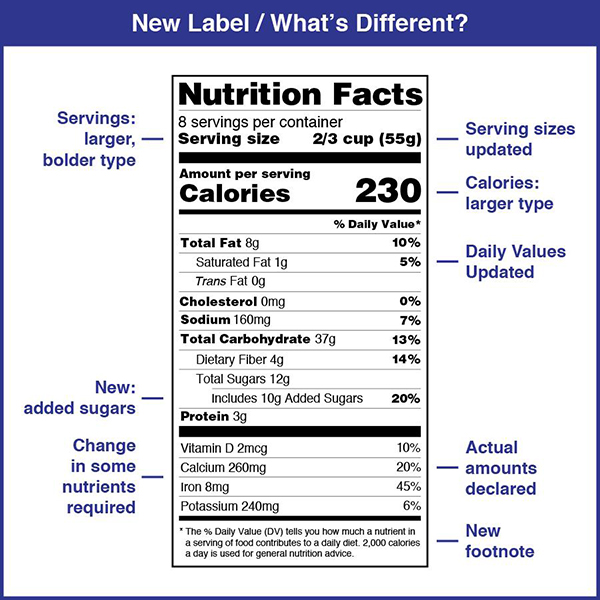Food Label Makeover
View All Section Pages

Food labels have remained the same since 1994 until recently. With emerging science and changes in the way Americans eat, a much needed food label update went into effect in 2020. These updates to food labels are outlined below to help you make the most informed nutrition choices.
Font size
The first noticeable change is the larger font size of serving sizes and calories are written in larger, bolder type. This change was made to allow this important information to stand out to the consumer in regard to portion awareness.
Serving Size
The order of the food label information has also been revamped to provide a more logical sequence. Now, the number of servings in the container is listed above the amount in a single serving size.
Another significant and warranted change to the serving size reflects a more realistic portion based on how much people actually eat. For example, a ½ cup serving of ice cream is now ⅔ cup. A 20 oz. soda bottle went from 2 servings to 1 serving per bottle since most people don’t just drink half a bottle of soda.
Tip: Whether you are trying to lose weight or simply make healthy food choices, pay attention to the serving size, keeping in mind how much you actually eat or drink.
Calories from fat
Science now shows it is better to eat healthier types of fats rather than eating less total fat. This is why the number of calories from fat has been removed from the label. Take note of the saturated fat content, which has been known to raise “bad” LDL cholesterol and is associated with increased risk of heart disease. Examples of foods higher in saturated fat include:
- Whole milk dairy foods such as cheese and butter
- High-fat meats
- Tropical oils such as coconut and palm oil
A good rule of thumb is if the food has 20% or more of saturated fat, don’t put the product in your shopping cart.
Tip: Aim to select foods that contain less than 20% saturated fat.

Source: https://www.fda.gov/food/food-labeling-nutrition/changes-nutrition-facts-label
Fiber
Just because a food has fiber, doesn’t automatically mean the fiber is beneficial to your health. Many people are unaware that some foods may have added fiber, or fiber that is not naturally present in a food. Examples of foods with added fiber are yogurts and protein drinks. The new label regulations only allow manufacturers to list fiber as a nutrient if it is beneficial for good health. For example, oats and psyllium contain natural fiber that can lower cholesterol and whole grains can aid in digestion.
Tip: When comparing similar products, choose the product that contains the most fiber. Fiber is naturally found in whole grains, beans, legumes, fruits, vegetables, nuts and seeds.
Added sugars vs. total sugars
The new label lists total sugars and added sugars, whereas the former label only listed total sugars. This particular change has been a long time coming and is a well-deserved position on the new food label. Most people look at the amount of total sugar as a negative thing without realizing that the total sugars includes both natural sugar (found in fruit or milk) and added sugars (found in candy and sweetened beverages).
Tip: Look for foods with no more than 5% of added sugars.
Sodium
Based on the 2020 Dietary Guidelines for Americans, adults should limit sodium to no more than 2,300 mg per day, 100 mg less per day than the previous guidelines. Reducing dietary sodium intake is especially important for those with high blood pressure, diabetes, kidney disease and heart disease.
Tip: Look for foods that have 5% or less sodium.
Vitamins and minerals
Research reveals that the typical American diet is deficient in potassium and vitamin D. The new label lists these two nutrients and listing vitamins A and C is now optional for manufacturers. Potassium plays a key role in lowering blood pressure while vitamin D is vital to bone health. Calcium and iron held their position on the new label as these nutrients are also lacking in the average American diet.
Tip: Look for foods with higher amounts of potassium, vitamin D, calcium and iron for a more balanced dietary intake.
Each change to the food label is designed to help consumers make the most educated and informed decisions when it comes to diet and nutrition. Take advantage of these new and improved updates when grocery shopping and meal planning to not only get the most bang for your buck, but to also achieve optimal nutrient levels in each and every meal.
To schedule a one-on-one consultation or learn more about Cooper Clinic Nutrition Services, visit cooperclinicnutrition.com or call 972.560.2655.
Article provided by Elana Paddock, RDN, LD, CDCES, and Cooper Clinic Nutrition Services.